Nitrogen Source Affects the Composition of Metabolites in Pepper (Capsicum annuum L.) and Regulates the Synthesis of Capsaicinoids through the GOGAT–GS Pathway
Abstract
1. Introduction
2. Materials and Methods
2.1. Plant Material and Growth Conditions
2.2. Steady-State Analysis of Polar Metabolites
2.3. Fruit Weight and Capsaicinoids Determination
2.4. Enzyme Activity
2.5. Quantitative RT-PCR
2.6. Statistical Analyses
3. Results
3.1. Overview of Metabolomic Profiling
3.2. Differential Metabolites between Pericarp and Placenta
3.3. Differential Metabolites among Treatments
3.4. Pathway Analysis of Metabolites
3.5. Fruit Weight and the Quantification of Capsaicinoids in Pepper
3.6. Analysis of PAL, CS, GOGAT, and GS Enzymes
3.7. Analysis of Gene Expression and Correlations
4. Discussion
4.1. Metabolism of Pepper Pericarp and Placenta
4.2. Ammonium: Nitrate Ratio Affects Metabolites of Pepper
4.3. Ammonia Nitrogen Addition Regulates Capsaicinoids Biosynthesis through the GOGAT/GS Cycle
5. Conclusions
Supplementary Materials
Author Contributions
Funding
Conflicts of Interest
References
- Carlisle, E.; Myers, S.; Raboy, V.; Bloom, A. The effects of inorganic nitrogen form and CO2 concentration on wheat yield and nutrient accumulation and distribution. Front Plant Sci. 2012, 3, 195. [Google Scholar] [CrossRef] [PubMed]
- Piwpuan, N.; Zhai, X.; Brix, H. Nitrogen nutrition of Cyperus laevigatus and Phormium tenax: Effects of ammonium versus nitrate on growth, nitrate reductase activity and N uptake kinetics. Aquat. Bot. 2013, 106, 42–51. [Google Scholar] [CrossRef]
- Miflin, B.J.; Habash, D.Z. The role of glutamine synthetase and glutamate dehydrogenase in nitrogen assimilation and possibilities for improvement in the nitrogen utilization of crops. J. Exp. Bot. 2002, 53, 979–987. [Google Scholar] [CrossRef] [PubMed]
- De Bona, F.D.; Fedoseyenko, D.; von Wirén, N.; Monteiro, F.A. Nitrogen utilization by sulfur-deficient barley plants depends on the nitrogen form. Environ. Exp. Bot. 2011, 74, 237–244. [Google Scholar] [CrossRef]
- Hu, L.; Liao, W.; Dawuda, M.M.; Yu, J.; Lv, J. Appropriate NH4+:NO3− ratio improves low light tolerance of mini Chinese cabbage seedlings. BMC Plant Biol. 2017, 17, 22. [Google Scholar] [CrossRef] [PubMed]
- Ruan, J.L.; Sattelmacher, B. Effect of nitrogen form and root-zone pH on growth and nitrogen uptake of tea (Camellia sinensis) plants. Ann. Bot. 2007, 99, 301. [Google Scholar] [CrossRef]
- Liu, G.; Du, Q.; Li, J. Interactive effects of nitrate-ammonium ratios and temperatures on growth, photosynthesis, and nitrogen metabolism of tomato seedlings. Sci. Hortic. 2017, 214, 41–50. [Google Scholar] [CrossRef]
- Obiadalla-Ali, H.; Fernie, A.R.; Kossmann, J.; Lloyd, J.R. Developmental analysis of carbohydrate metabolism in tomato (Lycopersicon esculentum cv. Micro-Tom) fruits. Physiol. Plant. 2004, 120, 196–204. [Google Scholar] [CrossRef]
- Chen, L.; Kang, Y.-H. Anti-inflammatory and antioxidant activities of red pepper (Capsicum annuum L.) stalk extracts: Comparison of pericarp and placenta extracts. J. Funct. Foods 2013, 5, 1724–1731. [Google Scholar] [CrossRef]
- Liu, S.; Chen, C.; Chen, G.; Cao, B.; Chen, Q.; Lei, J. RNA-sequencing tag profiling of the placenta and pericarp of pungent pepper provides robust candidates contributing to capsaicinoid biosynthesis. Plant Cell Tissue Org. Cult. (PCTOC) 2012, 110, 111–121. [Google Scholar] [CrossRef]
- Bosland, P.W.; Tojin Silva, J.P. Peppers: Vegetable and spice capsicums. Cabi Bookshop 2000, 2, 14–39. [Google Scholar]
- Mejia, L.A.; Hudson, E.; Mejía, E.G.D.; Vazquez, F. Carotenoid Content and Vitamin A Activity of Some Common Cultivars of Mexican Peppers (Cupsicum annuum) as Determined by HPLC. J. Food Sci. 2010, 53, 1440–1443. [Google Scholar] [CrossRef]
- Matsufuji, H.; Ishikawa, K.; Nunomura, O.; Chino, M.; Takeda, M. Anti-oxidant content of different coloured sweet peppers, white, green, yellow, orange and red (Capsicum annuum L.). Int. J. Food Sci. Technol. 2010, 42, 1482–1488. [Google Scholar] [CrossRef]
- Bosland, P.W.; Votava, E.J.; Votava, E.M. Peppers: Vegetable and Spice Capsicums; CABI: Wallingford, UK, 2012; p. 22. [Google Scholar]
- Iwai, K.; Suzuki, T.; Fujiwake, H.; Oka, S. Simultaneous microdetermination of capsaicin and its four analogues by using high-performance liquid chromatography and gas chromatography—Mass spectrometry. J. Chromatogr. 1979, 172, 303–311. [Google Scholar] [CrossRef]
- Nelson, E.K. The constitution of capsaicin—The pungent principle of Capsicum. J. Am. Chem. Soc. 1919, 188, 269. [Google Scholar]
- Chen, D.; Xiong, Y.; Lin, Y.; Tang, Z.; Wang, J.; Wang, L.; Yao, J. Capsaicin alleviates abnormal intestinal motility through regulation of enteric motor neurons and MLCK activity: Relevance to intestinal motility disorders. Mol. Nutr. Food Res. 2015, 59, 1482–1490. [Google Scholar] [CrossRef]
- Zheng, J.; Zheng, S.; Feng, Q.; Zhang, Q.; Xiao, X. Dietary capsaicin and its anti-obesity potency: From mechanism to clinical implications. Biosci. Rep. 2017, 37, BSR20170286. [Google Scholar] [CrossRef]
- Burness, C.B.; Mccormack, P.L. Capsaicin 8% Patch: A review in peripheral neuropathic pain. Drugs 2016, 76, 123–134. [Google Scholar] [CrossRef]
- Peppin, J.F.; Marco, P. Capsaicinoids in the treatment of neuropathic pain: A review. Ther. Adv. Neurol. Disord. 2014, 7, 22–32. [Google Scholar] [CrossRef]
- Masayuki, S.; Takeshi, Y. Capsinoids and related food ingredients activating brown fat thermogenesis and reducing body fat in humans. Curr. Opin. Lipidol. 2013, 24, 71–77. [Google Scholar]
- Clark, R.; Lee, S.H. Anticancer properties of capsaicin against human cancer. Anticancer Res. 2016, 36, 837. [Google Scholar] [PubMed]
- Ravishankar, G.A. Putrescine facilitated enhancement of capsaicin production in cell suspension cultures of Capsicum frutescens. J. Plant Physiol. 2003, 160, 339–346. [Google Scholar]
- Akladious, S.A.; Mohamed, H.I. Ameliorative effects of calcium nitrate and humic acid on the growth, yield component and biochemical attribute of pepper (Capsicum annuum) plants grown under salt stress. Sci. Hortic. 2018, 236, 244–250. [Google Scholar] [CrossRef]
- Gurung, T.; Techawongstien, S.; Techawongstien, S. Stability analysis of yield and capsaicinoids content in chili (Capsicum spp.) grown across six environments. Euphytica 2012, 187, 11–18. [Google Scholar] [CrossRef]
- Das, S.; Teja, K.C.; Duary, B.; Agrawal, P.K.; Bhattacharya, S.S. Impact of nutrient management, soil type and location on the accumulation of capsaicin in Capsicum chinense (Jacq.): One of the hottest chili in the world. Sci. Hortic. 2016, 213, 354–366. [Google Scholar] [CrossRef]
- Guinoza, A.A.; Siraichi, J.G.; Gazim, Z.C.; Cortez, D.A.G.; Cortez, L.E.R. Effects of organic fertilizer in the capsaicinoids of red pepper (Capsicum baccatum L.). J Med. Plants Res. 2015, 9, 787–791. [Google Scholar]
- Tabatabaei, S.J.; Fatemi, L.S.; Fallahi, E. Effect of ammonium: Nitrate ratio on yield, calcium concentration, and photosynthesis rate in strawberry. J. Plant Nutr. 2006, 29, 1273–1285. [Google Scholar] [CrossRef]
- Wang, L.; Gu, X.; Hua, M.; Mao, S.; Zhang, Z.; Peng, D.; Yun, X.; Zhang, B. A SCAR marker linked to the N gene for resistance to root knot nematodes (Meloidogyne spp.) in pepper (Capsicum annuum L.). Sci. Hortic. 2009, 122, 318–322. [Google Scholar] [CrossRef]
- Borrero, C.; Trillas, M.I.; Delgado, A.; Avilés, M. Effect of ammonium/nitrate ratio in nutrient solution on control of Fusarium wilt of tomato by Trichoderma asperellum T34. Plant Pathol. 2012, 61, 132–139. [Google Scholar] [CrossRef]
- Hoagland, D.R.; Arnon, D.I. The water-culture method for growing plants without soil. Calif. Agric. Exp. Stn. Circ. 1950, 347, 357–359. [Google Scholar]
- Cruz, J.L.; Alves, A.A.C.; Lecain, D.R.; Ellis, D.D.; Morgan, J.A. Effect of elevated CO2 concentration and nitrate: Ammonium ratios on gas exchange and growth of cassava (Manihot esculenta Crantz). Plant Soil 2014, 374, 33–43. [Google Scholar] [CrossRef]
- Xiao, J.F.; Zhou, B.; Ressom, H.W. Metabolite identification and quantitation in LC-MS/MS-based metabolomics. TrAC Trends Anal. Chem. 2012, 32, 1–14. [Google Scholar] [CrossRef] [PubMed]
- Barbero, G.F.; Liazid, A.; Palma, M.; Barroso, C.G. Fast determination of capsaicinoids from peppers by high-performance liquid chromatography using a reversed phase monolithic column. Food Chem. 2008, 107, 1276–1282. [Google Scholar] [CrossRef]
- Rizwan, M.; Mostofa, M.G.; Ahmad, M.Z.; Zhou, Y.; Adeel, M.; Mehmood, S.; Ahmad, M.A.; Javed, R.; Imtiaz, M.; Aziz, O. Hydrogen sulfide enhances rice tolerance to nickel through the prevention of chloroplast damage and the improvement of nitrogen metabolism under excessive nickel. Plant Physiol. Biochem. 2019, 138, 100–111. [Google Scholar] [CrossRef]
- Deng, M.; Wen, J.; Zhao, K.; Huo, J.; Zhang, Z.; Zhu, H.; Zou, X. A comprehensive view of expression profiles dynamics of capsaicinoid biosynthesis-related genes during pepper fruit development and under MeJA treatment. Preprints 2016, 2016080104. [Google Scholar] [CrossRef][Green Version]
- Keyhaninejad, N.; Curry, J.; Romero, J.; O’Connell, M.A. Fruit specific variability in capsaicinoid accumulation and transcription of structural and regulatory genes in Capsicum fruit. Plant Sci. 2014, 215-216, 59–68. [Google Scholar] [CrossRef]
- Livak, K.J.; Schmittgen, T.D. Analysis of relative gene expression data using real-time quantitative PCR and the 2-ΔΔCt method. Methods 2001, 25, 402–408. [Google Scholar] [CrossRef]
- Cho, K.; Cho, K.S.; Sohn, H.B.; Ha, I.J.; Hong, S.Y.; Lee, H.; Kim, Y.M.; Nam, M.H. Network analysis of the metabolome and transcriptome reveals novel regulation of potato pigmentation. J. Exp. Bot. 2016, 67, 1519. [Google Scholar] [CrossRef]
- Theodoridis, G.; Gika, H.G.; Wilson, I.D. LC-MS-based methodology for global metabolite profiling in metabonomics/metabolomics. TrAC Trends Anal. Chem. 2008, 27, 251–260. [Google Scholar] [CrossRef]
- Galindo-Prieto, B.; Eriksson, L.; Trygg, J. Variable influence on projection (VIP) for orthogonal projections to latent structures (OPLS). J. Chemom. 2014, 28, 623–632. [Google Scholar] [CrossRef]
- Abdi, H.; Williams, L.J. Principal component analysis. Wires Comput. Stats. 2010, 2, 433–459. [Google Scholar] [CrossRef]
- Minoru, K.; Susumu, G. KEGG: Kyoto encyclopedia of genes and genomes. Nucleic Acids Res. 2000, 28, 27–30. [Google Scholar]
- Yumei, J.; Bing, X.; Lijian, L.; Xiaodan, L.; Sheng, X.; Feng, P.; Ren, W. Molecular and analysis of a phenylalanine ammonia-lyase gene (LrPAL2) from Lycoris radiata. Mol. Biol. Rep. 2013, 40, 2293–2300. [Google Scholar]
- Wahyuni, Y.; Ballester, A.-R.; Sudarmonowati, E.; Bino, R.J.; Bovy, A.G. Metabolite biodiversity in pepper (Capsicum) fruits of thirty-two diverse accessions: Variation in health-related compounds and implications for breeding. Phytochemistry 2011, 72, 1358–1370. [Google Scholar] [CrossRef] [PubMed]
- Smirnoff, N. Vitamin C: The metabolism functions of ascorbic acid in plants. Adv. Bot. Res. 2011, 59, 109–177. [Google Scholar]
- Topuz, A.; Ozdemir, F. Assessment of carotenoids, capsaicinoids and ascorbic acid composition of some selected pepper cultivars (Capsicum annuum L.) grown in Turkey. J. Food Compos. Anal. 2007, 20, 596–602. [Google Scholar] [CrossRef]
- Guil-Guerrero, J.; Martínez-Guirado, C.; del Mar Rebolloso-Fuentes, M.; Carrique-Pérez, A. Nutrient composition and antioxidant activity of 10 pepper (Capsicum annuun) varieties. Eur. Food Res. Technol. 2006, 224, 1–9. [Google Scholar] [CrossRef]
- Perucka, I.; Materska, M. Phenylalanine ammonia-lyase and antioxidant activities of lipophilic fraction of fresh pepper fruits Capsicum annum L. Innov. Food Sci. Emerg. Technol. 2001, 2, 189–192. [Google Scholar] [CrossRef]
- Canto-Flick, A.; Balam-Uc, E.; Bello-Bello, J.J.; Lecona-Guzmán, C.; Solís-Marroquín, D.; Avilés-Viñas, S.; Gómez-Uc, E.; López-Puc, G.; Santana-Buzzy, N.; Iglesias-Andreu, L.G. Capsaicinoids content in habanero pepper (Capsicum chinense Jacq.): Hottest known cultivars. HortScience 2008, 43, 1344–1349. [Google Scholar] [CrossRef]
- Tanaka, Y.; Yoneda, H.; Hosokawa, M.; Miwa, T.; Yazawa, S. Application of marker-assisted selection in breeding of a new fresh pepper cultivar (Capsicum annuum) containing capsinoids, low-pungent capsaicinoid analogs. Sci. Hortic. 2014, 165, 242–245. [Google Scholar] [CrossRef]
- Stewart, C., Jr.; Kang, B.C.; Liu, K.; Mazourek, M.; Moore, S.L.; Yoo, E.Y.; Kim, B.D.; Paran, I.; Jahn, M.M. The Pun1 gene for pungency in pepper encodes a putative acyltransferase. Plant J. 2010, 42, 675–688. [Google Scholar] [CrossRef] [PubMed]
- Kim, S.; Park, M.; Yeom, S.I.; Kim, Y.M.; Lee, J.M.; Lee, H.A.; Seo, E.; Choi, J.; Cheong, K.; Kim, K.T. Genome sequence of the hot pepper provides insights into the evolution of pungency in Capsicum species. Nat. Genet. 2014, 46, 270–278. [Google Scholar] [CrossRef] [PubMed]
- Qin, C.; Yu, C.; Shen, Y.; Fang, X.; Chen, L.; Min, J.; Cheng, J.; Zhao, S.; Xu, M.; Luo, Y. Whole-genome sequencing of cultivated and wild peppers provides insights into Capsicum domestication and specialization. Natl. Proc. Acad. Sci. USA 2014, 111, 5135–5140. [Google Scholar] [CrossRef] [PubMed]
- Deng, M.H.; Wen, J.F.; Zhu, H.S.; Zou, X.X. The hottest pepper variety in China. Genet. Resour. Crop Evol. 2009, 56, 605–608. [Google Scholar] [CrossRef]
- Urlić, B.; Špika, M.J.; Becker, C.; Kläring, H.P.; Krumbein, A.; Ban, S.G.; Schwarz, D. Effect of NO3 and NH4 concentrations in nutrient solution on yield and nitrate concentration in seasonally grown leaf lettuce. Acta Agric. Scand. B Soil Plant Sci. 2017, 67, 1–10. [Google Scholar]
- Wada, S.; Niedz, R.P.; Reed, B.M. Determining nitrate and ammonium requirements for optimal in vitro response of diverse pear species. In Vitro Cell. Dev. Biol. Plant 2015, 51, 19–27. [Google Scholar] [CrossRef]
- Sokri, S.M.; Babalar, M.; Barker, A.V.; Lesani, H.; Asgari, M.A. Fruit quality and nitrogen, potassium, and calcium content of apple as influenced by nitrate: Ammonium ratios in tree nutrition. J. Plant Nutr. 2015, 38, 1619–1627. [Google Scholar] [CrossRef]
- Sandoval-Villa, M.; Wood, C.W.; Guertal, E.A. Effects of nitrogen form, nighttime nutrient solution strength, and cultivar on greenhouse tomato production. J. Plant Nutr. 1999, 22, 1931–1945. [Google Scholar] [CrossRef]
- Marti, H.; Mills, H. Nutrient uptake and yield of sweet pepper as affected by stage of development and N form. J. Plant Nutr. 1991, 14, 1165–1175. [Google Scholar] [CrossRef]
- Bar-Tal, A.; Aloni, B.; Karni, L.; Oserovitz, J.; Hazan, A.; Itach, M.; Gantz, S.; Avidan, A.; Posalski, I.; Tratkovski, N. Nitrogen nutrition of greenhouse pepper. I. Effects of nitrogen concentration and NO3: NH4 ratio on yield, fruit shape, and the incidence of blossom-end rot in relation to plant mineral composition. HortScience 2001, 36, 1244–1251. [Google Scholar] [CrossRef]
- Zhao, C.J.; Schieber, A.; Gänzle, M.G. Formation of taste-active amino acids, amino acid derivatives and peptides in food fermentations—A review. Food Res. Int. 2016, 89, 39–47. [Google Scholar] [CrossRef] [PubMed]
- Sheng, L.; Shen, D.; Luo, Y.; Sun, X.; Wang, J.; Luo, T.; Zeng, Y.; Xu, J.; Deng, X.; Cheng, Y. Exogenous γ-aminobutyric acid treatment affects citrate and amino acid accumulation to improve fruit quality and storage performance of postharvest citrus fruit. Food Chem. 2017, 216, 138–145. [Google Scholar] [CrossRef] [PubMed]
- Causin, H.F. The central role of amino acids on nitrogen utilization and plant growth. J. Plant Physiol. 1996, 149, 358–362. [Google Scholar]
- Kołton, A.; Wojciechowska, R.; Leja, M. The effect of various light conditions and different nitrogen forms on nitrogen metabolism in pepper fruits. Folia Hortic. 2012, 24, 153–160. [Google Scholar] [CrossRef]
- Sailaja, P.; Podile, A.; Reddanna, P. Biocontrol strain of Bacillus subtilis AF 1 rapidly induces lipoxygenase in groundnut (Arachis hypogaea L.) compared to crown rot pathogen Aspergillus niger. Eur. J. Plant Pathol. 1998, 104, 125–132. [Google Scholar] [CrossRef]
- Bunik, V.I.; Fernie, A.R. Metabolic control exerted by the 2-oxoglutarate dehydrogenase reaction: A cross-kingdom comparison of the crossroad between energy production and nitrogen assimilation. Biochem. J. 2009, 422, 405–421. [Google Scholar] [CrossRef]
- Rawsthorne, S.; Minchin, F.R.; Summerfield, R.J.; Cookson, C.; Coombs, J. Carbon and nitrogen metabolism in legume root nodules. Phytochemistry 1980, 19, 341–355. [Google Scholar] [CrossRef]
- Lu, Y.; Luo, F.; Yang, M.; Li, X.; Lian, X. Suppression of glutamate synthase genes significantly affects carbon and nitrogen metabolism in rice (Oryza sativa L.). Sci. China Life Sci. 2011, 54, 651–663. [Google Scholar] [CrossRef]
- Smolander, A.; Kanerva, S.; Adamczyk, B.; Kitunen, V. Nitrogen transformations in boreal forest soils—Does composition of plant secondary compounds give any explanations? Plant Soil 2012, 350, 1–26. [Google Scholar] [CrossRef]
- Bennett, R.N.; Wallsgrove, R.M. Secondary metabolites in plant defence mechanisms. New Phytol. 2006, 127, 617–633. [Google Scholar] [CrossRef]
- Aluru, M.R.; Mazourek, M.; Landry, L.G.; Curry, J.; Jahn, M.; O’Connell, M.A. Differential expression of fatty acid synthase genes, Acl, Fat and Kas, in Capsicum fruit. J. Exp. Bot. 2003, 54, 1655–1664. [Google Scholar] [CrossRef] [PubMed]
- Curry, J.; Aluru, M.; Mendoza, M.; Nevarez, J.; Melendrez, M.; O’Connell, M.A. Transcripts for possible capsaicinoid biosynthetic genes are differentially accumulated in pungent and non-pungent Capsicum spp. Plant Sci. 1999, 148, 47–57. [Google Scholar] [CrossRef]
- Mazourek, M.; Pujar, A.; Borovsky, Y.; Paran, I.; Mueller, L.; Jahn, M.M. A dynamic interface for capsaicinoid systems biology. Plant Physiol. 2009, 150, 1806–1821. [Google Scholar] [CrossRef] [PubMed]
- Reddy, U.K.; Almeida, A.; Abburi, V.L.; Alaparthi, S.B.; Unselt, D.; Hankins, G.; Park, M.; Choi, D.; Nimmakayala, P. Identification of gene-specific polymorphisms and association with capsaicin pathway metabolites in Capsicum annuum L. collections. PLoS ONE 2014, 9, e86393. [Google Scholar] [CrossRef] [PubMed]
- Zhang, J.; Lv, J.; Dawuda, M.M.; Xie, J.; Yu, J.; Li, J.; Zhang, X.; Tang, C.; Wang, C.; Gan, Y. Appropriate ammonium-nitrate ratio improves nutrient accumulation and fruit quality in pepper (Capsicum annuum L.). Agronomy 2019, 9, 683. [Google Scholar] [CrossRef]
- Collos, Y.; Harrison, P.J. Acclimation and toxicity of high ammonium concentrations to unicellular algae. Mar. Pollut. Bull. 2014, 80, 8–23. [Google Scholar] [CrossRef]
- Li, S.-X.; Wang, Z.-H.; Stewart, B. Responses of crop plants to ammonium and nitrate N. Adv. Agron. 2013, 118, 205–397. [Google Scholar]

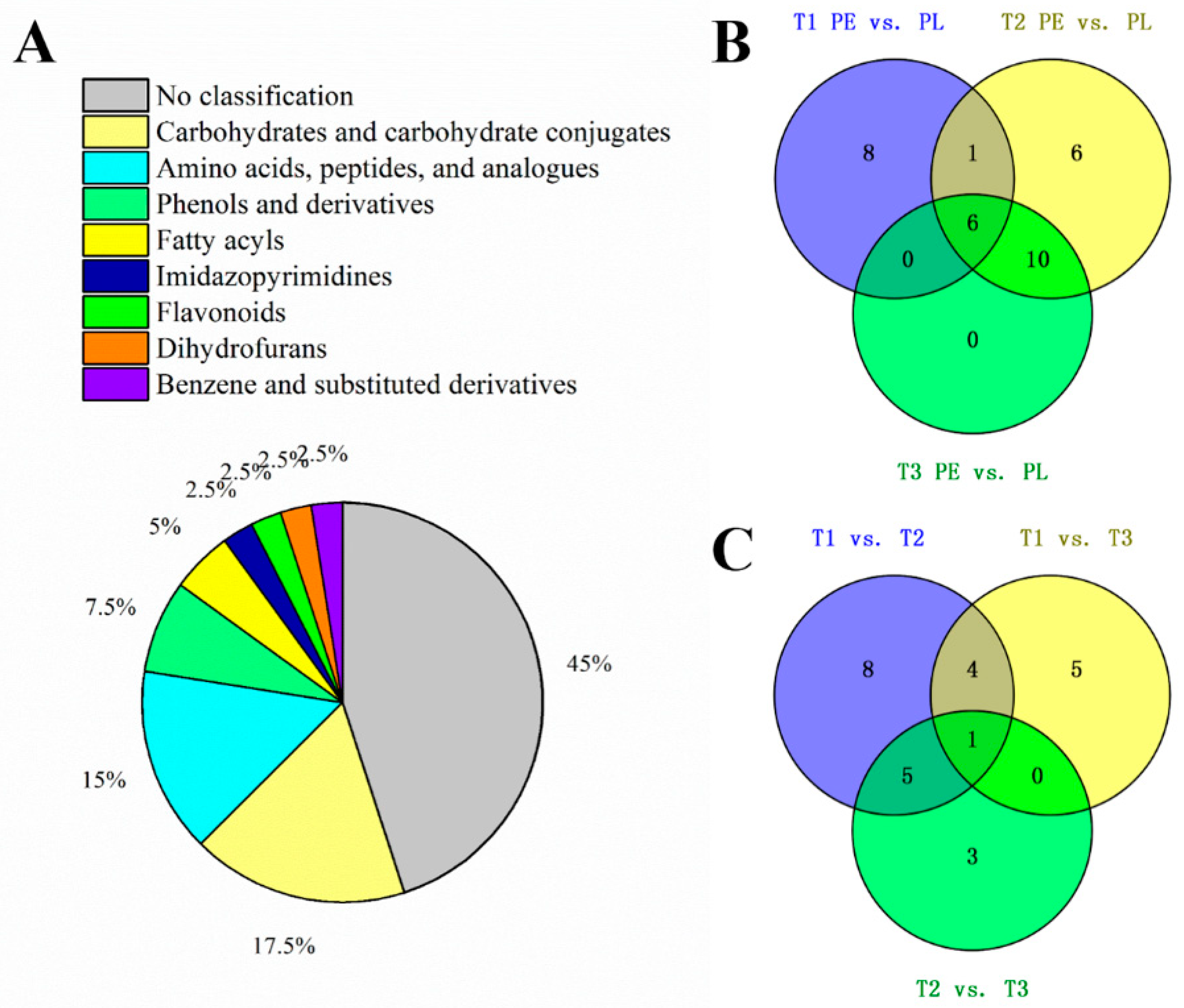

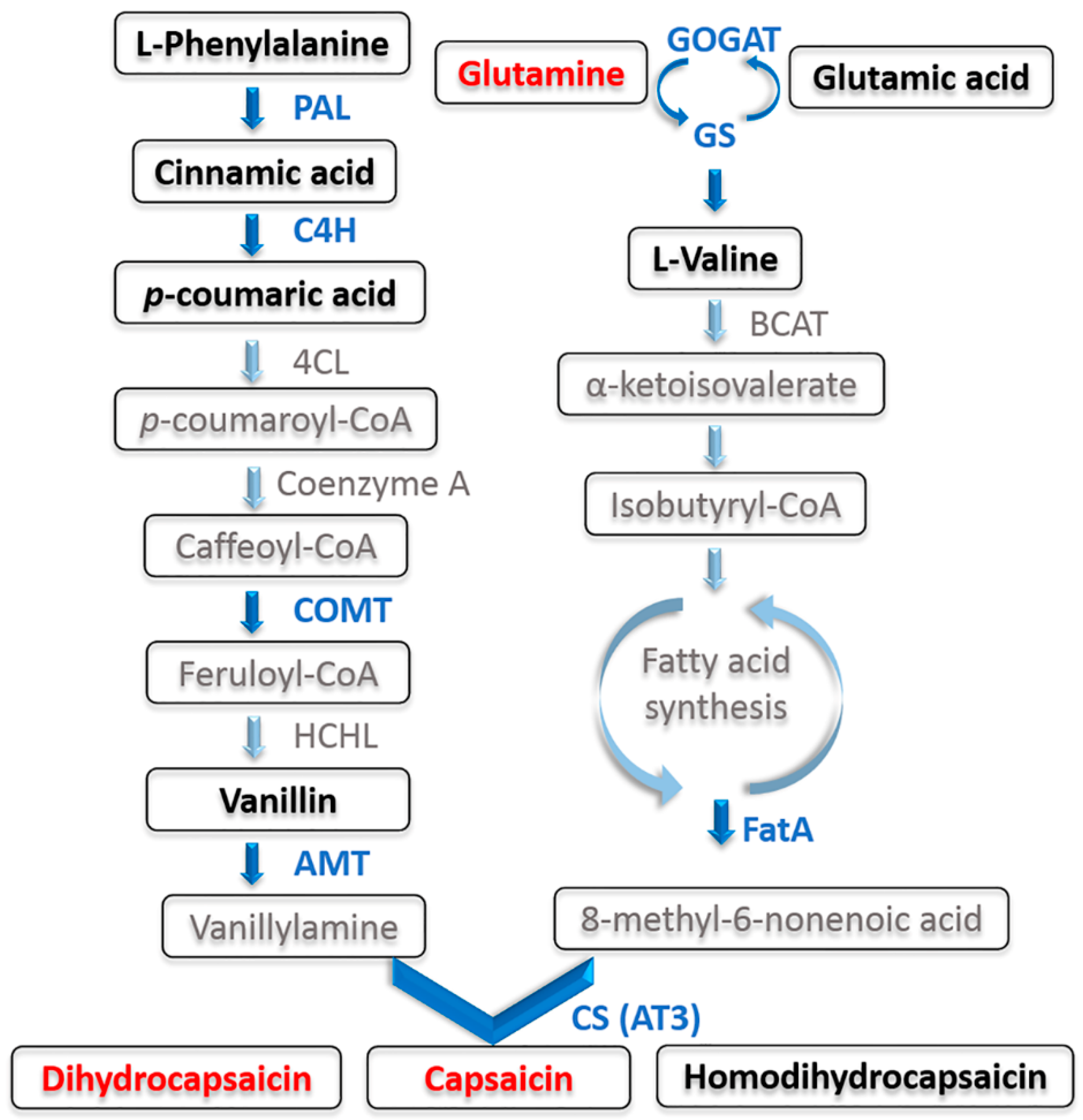
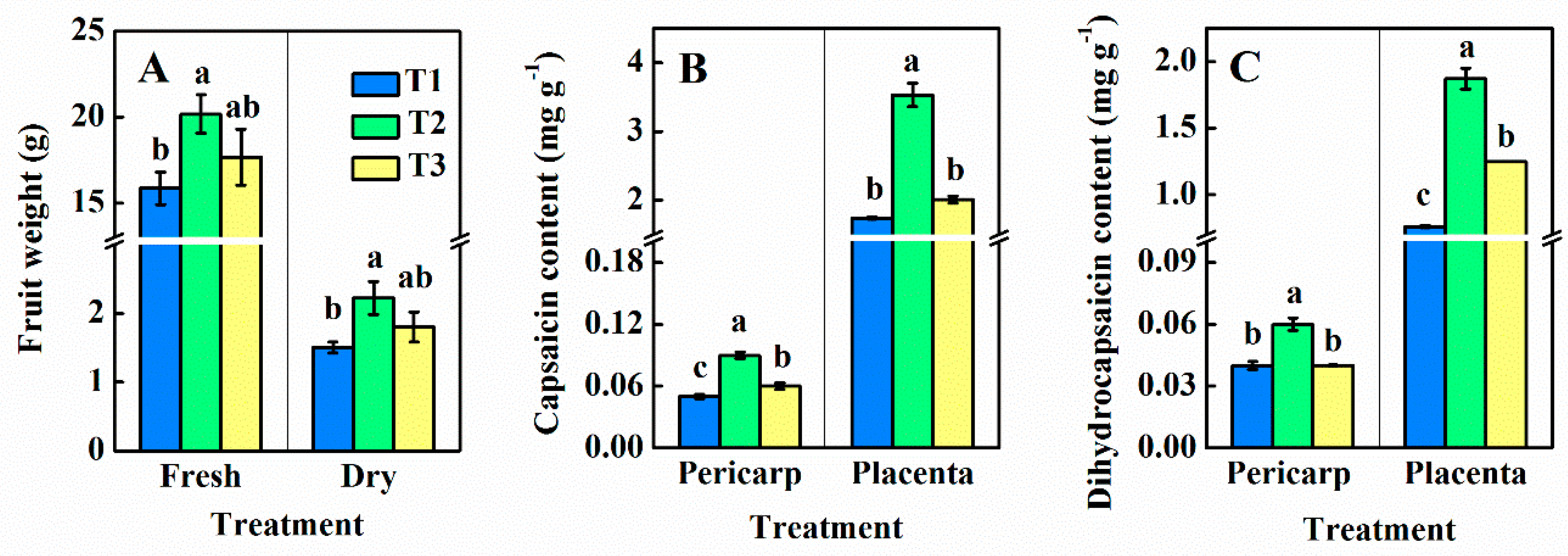

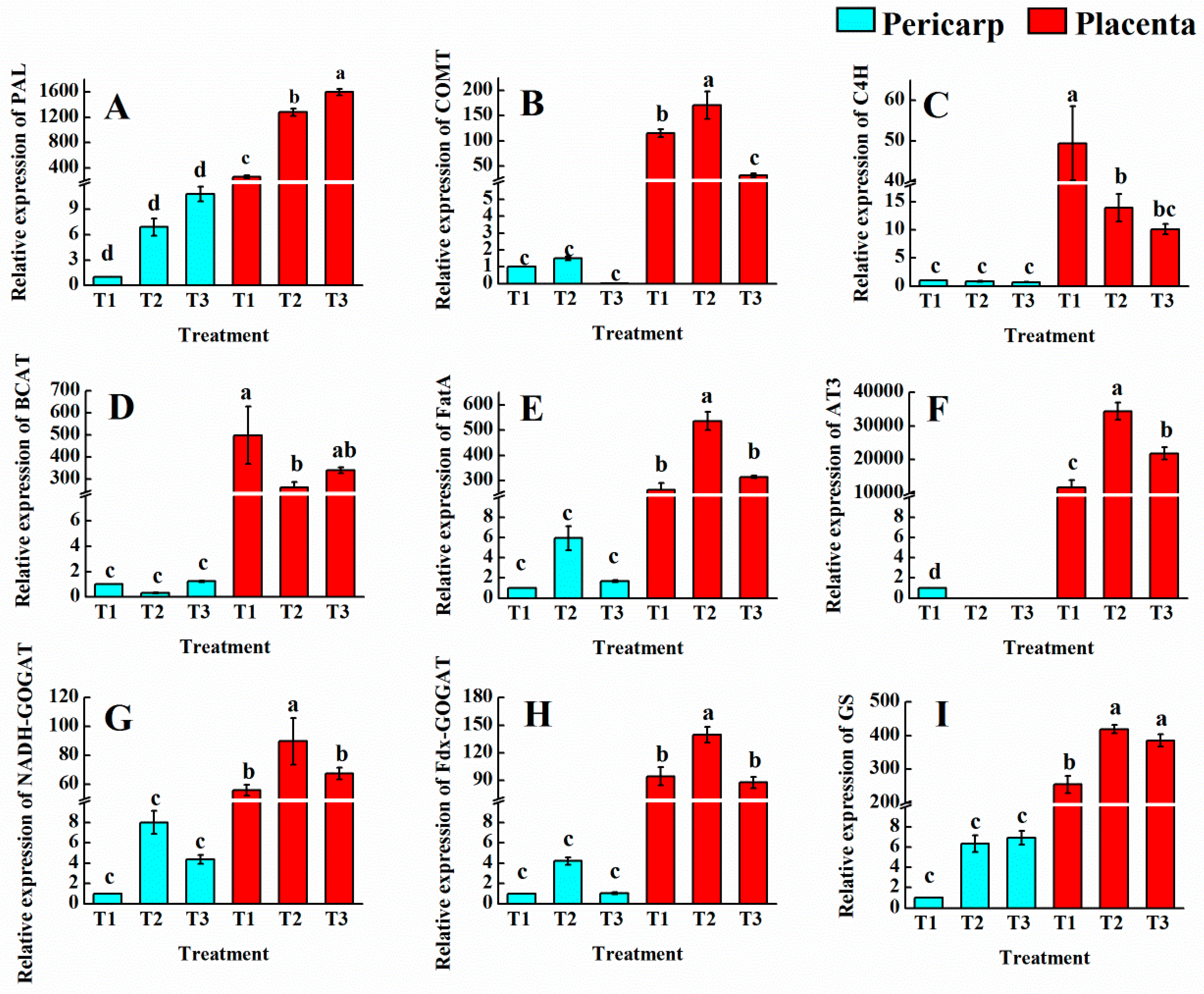
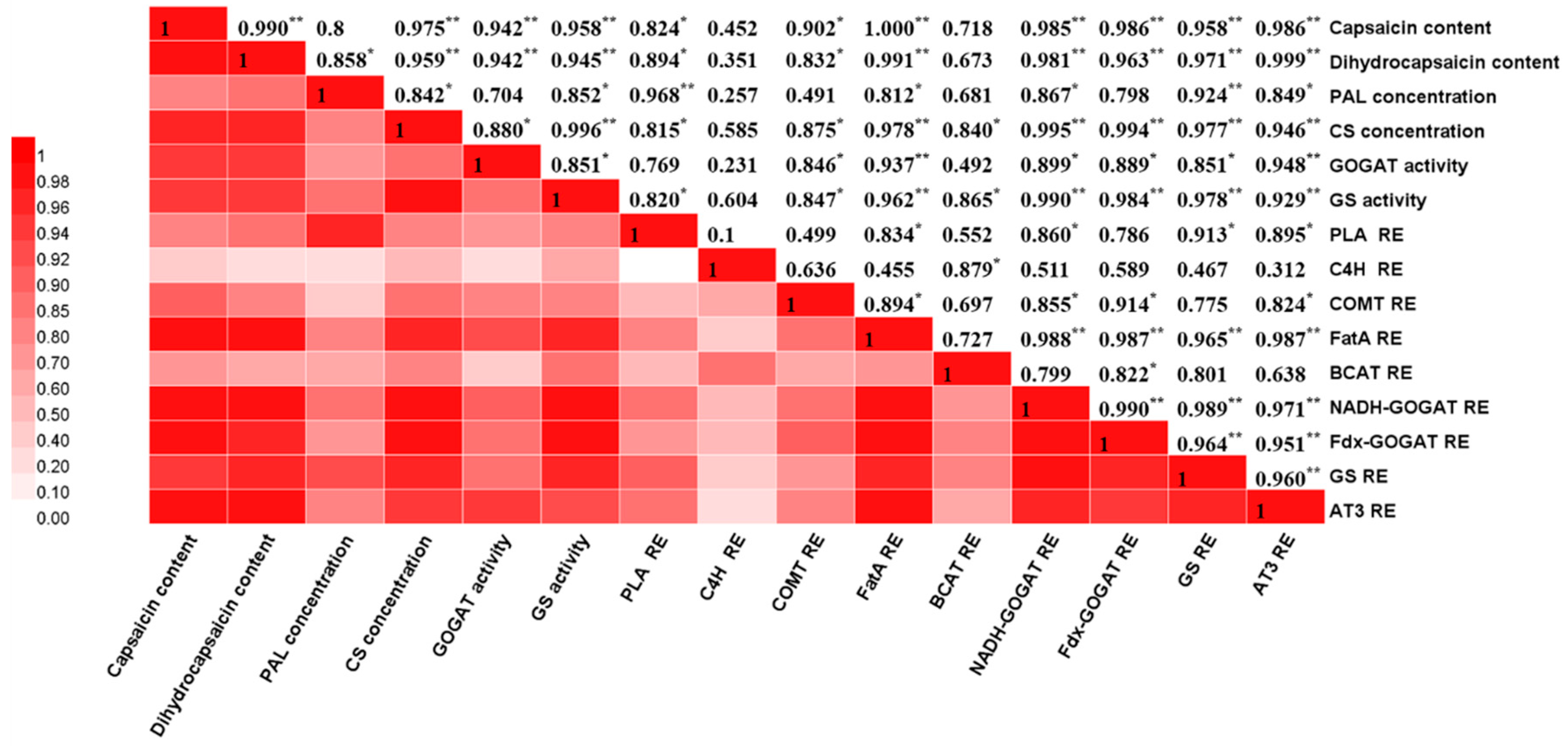
| Gene | Sequence (5′-3′) | Accession Number |
|---|---|---|
| PAL | F: 5′-CAACAGCAACATCACCCCATGTTTGC-3′ | AF081215 |
| R: 5′-GCTGCAACTCGAAAAATCCACCAC-3′ | ||
| C4H | F: 5′-TCAGATTCCTTCCATTCGGT-3′ | EU620574 |
| R: 5′-CTTTCTCCGTGGTGTCGAG-3′ | ||
| COMT | F: 5′-AAACAAGCCATAGCCTAACTCAAAC-3′ | AF081214 |
| R: 5′-AAGTAGCAAGAAGCCTAAACATTCG-3′ | ||
| BCAT | F: 5′-AAAGCGTTTAGAAGAGAGGATGG-3′ | AY034379 |
| R: 5′-GACAAGGAATGTGTACTCAGGTG-3′ | ||
| FatA | F: 5′-CAATGTTGTCTCGGGGGAGTTTTC-3′ | AF318288 |
| R: 5′-CTCTCTCTCTCATTAGTAGCTACAGC-3′ | ||
| AT3 | F: 5′-CCTCATGCATCTCTTGCAGAGAGCATAG-3′ | AY819027 |
| R: 5′-GTCGTATGATCACGAGTAACGCTAGACC-3′ | ||
| GS | F: 5′-GGAAGGGACACAGAGAAGGC-3′ | XM_016717075.1 |
| R: 5′-AACAAGCGATCCTTCGAGCA-3′ | ||
| NADH-GOGAT | F: ATGAATGATGACGAGGACTTTGC | EU616574 |
| R: GTCACGACTGTTTGCTT | ||
| Fdx-GOGAT | F: TTGGGAAAGGAGTTGATGGG | EU616563 |
| R: AACAGCACCTACAGCAAGAAGAAT | ||
| Actin | F: GTCCTTCCATCGTCCACAGG | XM_016722297.1 |
| R: GAAGGGCAAAGGTTCACAACA |
| Treatments | Pathway | Total | Hits | Raw p | Impact |
|---|---|---|---|---|---|
| T1 PE vs. PL | Biosynthesis of alkaloids derived from terpenoid and polyketide | 4 | 2 | 0.04 | 0.18 |
| Carbon metabolism | 4 | 2 | 0.04 | 0.18 | |
| Taste transduction | 4 | 2 | 0.04 | 0.18 | |
| Rel cell carcinoma | 1 | 1 | 0.09 | 0.09 | |
| Biosynthesis of secondary metabolites - unclassified | 1 | 1 | 0.09 | 0.09 | |
| Pathways in cancer | 1 | 1 | 0.09 | 0.09 | |
| Methane metabolism | 1 | 1 | 0.09 | 0.09 | |
| Pentose phosphate pathway | 1 | 1 | 0.09 | 0.09 | |
| Carbon fixation in photosynthetic organisms | 1 | 1 | 0.09 | 0.09 | |
| Starch and sucrose metabolism | 1 | 1 | 0.09 | 0.09 | |
| T2 PE vs. PL | Phosphotransferase system (PTS) | 4 | 3 | 0.04 | 0.32 |
| Galactose metabolism | 2 | 2 | 0.05 | 0.24 | |
| Carbohydrate digestion and absorption | 2 | 2 | 0.05 | 0.24 | |
| T3 PE vs. PL | Central carbon metabolism in cancer | 6 | 3 | 0.07 | 0.36 |
| PE T1 vs. T2 | Microbial metabolism in diverse environments | 12 | 4 | 0.01 | 0.22 |
| Caffeine metabolism | 1 | 1 | 0.05 | 0.05 | |
| Pentose phosphate pathway | 1 | 1 | 0.05 | 0.05 | |
| Glycine, serine and threonine metabolism | 1 | 1 | 0.05 | 0.05 | |
| Biosynthesis of secondary metabolites | 26 | 4 | 0.10 | 0.47 | |
| PL T1 vs. T2 | Carbohydrate digestion and absorption | 2 | 2 | 0.01 | 0.11 |
| Galactose metabolism | 2 | 2 | 0.01 | 0.11 | |
| Phosphotransferase system (PTS) | 4 | 2 | 0.05 | 0.22 | |
| PE T1 vs. T3 | Caffeine metabolism | 1 | 1 | 0.05 | 0.05 |
| PL T1 vs. T3 | Carbohydrate digestion and absorption | 2 | 2 | 0.04 | 0.04 |
| Galactose metabolism | 2 | 2 | 0.04 | 0.04 | |
| Phosphotransferase system (PTS) | 4 | 2 | 0.07 | 0.07 | |
| PE T2 vs. T3 | Pentose phosphate pathway | 1 | 1 | 0.04 | 0.04 |
| PL T2 vs. T3 | Mineral absorption | 2 | 1 | 0.04 | 0.04 |
| Alanine, aspartate and glutamate metabolism | 3 | 1 | 0.05 | 0.05 | |
| Cyanoamino acid metabolism | 3 | 1 | 0.05 | 0.05 | |
| Aminoacyl-tRNA biosynthesis | 4 | 1 | 0.07 | 0.07 | |
| Protein digestion and absorption | 4 | 1 | 0.07 | 0.07 |
© 2020 by the authors. Licensee MDPI, Basel, Switzerland. This article is an open access article distributed under the terms and conditions of the Creative Commons Attribution (CC BY) license (http://creativecommons.org/licenses/by/4.0/).
Share and Cite
Zhang, J.; Lv, J.; Xie, J.; Gan, Y.; Coulter, J.A.; Yu, J.; Li, J.; Wang, J.; Zhang, X. Nitrogen Source Affects the Composition of Metabolites in Pepper (Capsicum annuum L.) and Regulates the Synthesis of Capsaicinoids through the GOGAT–GS Pathway. Foods 2020, 9, 150. https://doi.org/10.3390/foods9020150
Zhang J, Lv J, Xie J, Gan Y, Coulter JA, Yu J, Li J, Wang J, Zhang X. Nitrogen Source Affects the Composition of Metabolites in Pepper (Capsicum annuum L.) and Regulates the Synthesis of Capsaicinoids through the GOGAT–GS Pathway. Foods. 2020; 9(2):150. https://doi.org/10.3390/foods9020150
Chicago/Turabian StyleZhang, Jing, Jian Lv, Jianming Xie, Yantai Gan, Jeffrey A. Coulter, Jihua Yu, Jing Li, Junwen Wang, and Xiaodan Zhang. 2020. "Nitrogen Source Affects the Composition of Metabolites in Pepper (Capsicum annuum L.) and Regulates the Synthesis of Capsaicinoids through the GOGAT–GS Pathway" Foods 9, no. 2: 150. https://doi.org/10.3390/foods9020150
APA StyleZhang, J., Lv, J., Xie, J., Gan, Y., Coulter, J. A., Yu, J., Li, J., Wang, J., & Zhang, X. (2020). Nitrogen Source Affects the Composition of Metabolites in Pepper (Capsicum annuum L.) and Regulates the Synthesis of Capsaicinoids through the GOGAT–GS Pathway. Foods, 9(2), 150. https://doi.org/10.3390/foods9020150






